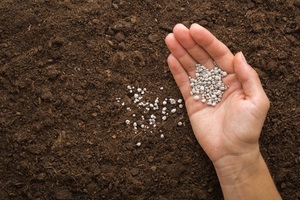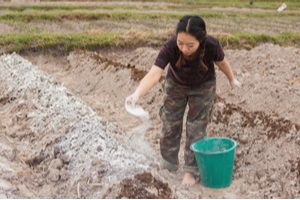 Many factors go into determining what makes for good soil. However, even when your soil has the perfect consistency and drainage features, its composition will still have a significant influence on the success of your garden. In some cases, the soil’s calcium content may need adjusting to achieve the perfect balance. Here is a closer look at why and how to add calcium to your soil.
Many factors go into determining what makes for good soil. However, even when your soil has the perfect consistency and drainage features, its composition will still have a significant influence on the success of your garden. In some cases, the soil’s calcium content may need adjusting to achieve the perfect balance. Here is a closer look at why and how to add calcium to your soil.
Why Does Soil Need Calcium?
Just as our bones and teeth need calcium for strength, your plant’s cell walls also depend on this mineral for health. Calcium is responsible for building the strong cell walls that keep your plant upright, and it also facilitates the transport of other minerals within the plant. In addition, calcium can counteract alkali salts and organic acids in your plant. In short, incorporating calcium into your soil is like giving your garden vitamins.
Calcium may not be needed in the same quantities that potassium, nitrogen and phosphorus are required, but it is nevertheless essential for helping your plants resist diseases and pests and grow strong. However, it is important to strike the right balance as too much calcium in the soil can raise the pH and make the soil too alkaline, impacting the absorption of macronutrients from other fertilizers.
How Can You Tell If Your Soil Needs Calcium?
If you notice your plants experiencing stunted growth in their leaves or shoots, inhibited bud growth, dead or stunted root tips, spotting or scorching on young leaves, yellowing leaves, burnt leaf tips, blossom end rot on tomatoes, other types of fruit damage, or coupling of mature leaves, these are all potential signs of calcium deficiency.
However, the best way to determine whether you should add calcium to your soil is with a professional soil test. This should not be confused with a simple pH test that can be carried out at home; a professional soil test will analyze not just the pH of your soil but also its calcium levels. A good soil test offered by your state Cooperative Extension can also indicate what needs to be added to your soil and in what amounts.
Types Of Calcium Fertilizers
There are many sources of calcium that can be used to improve your soil. Found in more than 75 different chemical compounds, there are lots of good ways to introduce more calcium into your garden.
 Some of these calcium compounds are insoluble and do not break down easily in water. Although this makes it harder for your plants to access the calcium in the soil, it means it will stay within the soil better and make its pH more balanced.
Some of these calcium compounds are insoluble and do not break down easily in water. Although this makes it harder for your plants to access the calcium in the soil, it means it will stay within the soil better and make its pH more balanced.
When it comes to the many options for adding calcium to soil, the right choice will depend on the type of crops you are growing and the pH of your soil. Here is a closer look at some of the most common types of calcium fertilizers.
Lime
Lime is one of the biggest calcium boosters a garden can receive. It often comes in the form of calcium carbonate and other forms of mined limestone. However, keep in mind that adding lime will also raise your soil’s pH and make it less acidic, so this is not the best choice for soil whose pH is already too high.
Foliar Spray
Commercial foliar calcium sprays such as calcium nitrate, calcium chloride and calcium acetate are a quick way to correct a severe calcium deficiency because plants absorb nutrients through their leaves more efficiently than they do through their roots. It is also a good approach for container plants, such as transplants and seedlings. These sprays do not amend the soil and are therefore more of a supplement to good soil nutrition management than a long-term solution.
Gypsum
A fast-acting calcium sulfate supplement known as gypsum is a good choice when you do not want to raise or lower the pH of your soil.
Ground Oyster Or Clam Shell Flour
Ground oyster or clam shell flour is a good source of calcium in the form of calcium carbonate, but it is important to keep in mind that these shells do have a low solubility and will take several years before they become effective. They can also raise the soil’s pH slightly over time.
Dolomite Lime
Dolomite lime, or calcium carbonate, is a great way to add a significant amount of calcium to your soil while also raising the pH of low-magnesium soils. This is not the right choice, however, if your soil test indicates that your soil’s levels of magnesium are already high.
Wood Ash
Wood ash from a fireplace or fire pit can increase the calcium in soil, but avoid using ashes from softwoods as they can damage plants. Stick to hardwood ashes, and keep in mind that they can increase your soil’s pH so it is best to avoid this method if your soil is alkaline.
Bone Meal
Bone meal is a high-phosphate fertilizer that releases more slowly than lime and is less soluble. It is a good choice in situations where you need to raise your pH only moderately, especially for root crops and bulbs.
DIY Calcium Spray
 It is also possible to create your own calcium spray for your plant’s leaves. You can create a chamomile calcium fertilizer by adding 1/4 cup of chamomile blossoms to a few cups of boiling water. If you do not have access to the blossoms, you can use cooled chamomile tea in a plastic spray bottle. This solution will last for up to a week.
It is also possible to create your own calcium spray for your plant’s leaves. You can create a chamomile calcium fertilizer by adding 1/4 cup of chamomile blossoms to a few cups of boiling water. If you do not have access to the blossoms, you can use cooled chamomile tea in a plastic spray bottle. This solution will last for up to a week.
Alternatively, you can create a seaweed calcium fertilizer by putting some chopped seaweed in a bucket and adding a few gallons of water. Cover this loosely and let it sit for two weeks and then dilute it with a gallon of water for each 2/3 cups of the mixture. Spray it directly onto your plant’s leaves.
Get In Touch With The Soil Experts At Dirt Connections
At Dirt Connections, we specialize in delivering a broad range of soil and dirt throughout the Northern Virginia area. Get in touch today to find out how we can help you with your gardening and home improvement projects.
Summary

Dirt Connections was started with one goal in mind: providing quality residential and commercial construction services to clients on time and on budget. Reach out for more information on how we can support your next project.
For your convenience our estimates are free and by appointment. Call 703-940-9949 for a free estimate today!










































